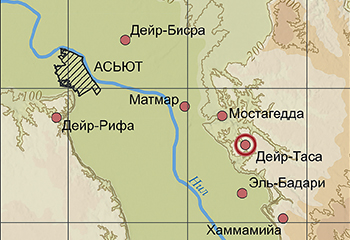Tasa
- Region:
- Northeastern Africa
- Timespan:
- c. 4750–4455 BC
- Coordinates:
- 27.05
31.42
TASA — an Early Neolithic culture, which developed in Middle Egypt c. 4750–4455 BC. It acquired its name from the Deir Tasa village located 4–5 km inland on the right bank of the Nile, southeast of Asyut, Asyut Governorate.
TASA — an Early Neolithic culture, which developed in Middle Egypt c. 4750–4455 BC. It acquired its name from the Deir Tasa village located 4–5 km inland on the right bank of the Nile, southeast of Asyut, Asyut Governorate (Fig. 1).
Discovery and Attribution
The excavations were carried out by British Egyptologist G. Brunton in 1927–1929 and by Egyptian archaeologist Sami Gabra in 1929 [Brunton 1929; 1937; Gabra 1930]. The findings still cause a discussion about the classification of the Tasian culture.
Brunton, who also discovered the Badarian culture, considered the Tasian as its direct predecessor based on features of 45 adult and child burials. These burials exhibit distinct craniological features of the dead, pit structure, and composition and materials of burial goods, some of which he attributed to Fayoum and Nubian (Sudanese) Neolithic traditions.
However, a number of Egyptologists have categorised Tasian culture as an early phase or a local type (specific to Mostagedda region) of Badarian culture, in particular due to close similarities in lithic industries and pottery.
The widely accepted current view considers the Tasians as a group of desert inhabitants to the east (and partially to the west) of the Nile, who supplied the settled population of the river valley with ornamental stone, copper, galena (‘lead glance’), and other items [Baumgartel 1947: 20–21; Hoffman 1979: 142; Holmes 1989; Midant-Reynes 2000: 166; Friedman, Hobbs 2002; Horn 2017].
Camps and Dwellings
Tasian dwellings consisted of huts or shelters erected on wooden poles. They were positioned close to the Nile plateau spurs, but further from the river than the main Badarian sites. This may reflect the tendency of Egyptian Neolithic settlements to move closer to the Nile with their transition towards the production economy.
Burials
Tasian graves, dug as oval or, less commonly, rectangular pits with rounded corners more than one metre deep, were covered with reed mats. Bodies were placed mainly in a contracted position on their left side, with their heads to the south. Some graves featured headrests made of straw laid under the skull. Corpses were covered or wrapped with reed mattings or skins, or sometimes placed in wicker coffin-like structures. There were joint burials of women and children.
Most burial pits had ceramic vessels, some placed in side niches. Among other burial goods there were stone palettes, ivory bracelets and spoons, ivory and shell beads, and amulets.
A plundered group burial of 14 adults and children, supposedly of Tasian origin, was discovered in Wadi Atulla in the Eastern Desert.
Tools and Ceramics
Tasian stone tools included axes, knives, arrowheads, sickle inserts, and grinding stones. Awls, pins, needles, and fishhooks were made of bone.
Found ceramics were predominantly brown and grey-black with a rough surface; black-topped red ware, typical for the Badari culture, is almost absent. Tasian pots and bowls had flat or rounded bases, straight walls, were cone-shaped, semi-spheric, and had narrowing ribbed necks (Fig. 2, 3).
According to Brunton, typical Tasian ceramics were black and brownish-black irregularly polished caliciform beakers with a rounded base, a wide bell, and incised ornament of straight lines, zigzags and triangles filled in with white paste (Fig. 4, 5).
Occupation and Diet
Tasians were hunters and fishermen, with some rudimentary sheep and goat breeding. There were no reliable signs of agricultural activities. Based on the dental anthropological data, intensive gathering prevailed, though cereals did not yet play a significant role in the diet [Friedman, Hobbs 2002: 184].
Bibliography
Baumgartel 1947 — Baumgartel, E. J. The Cultures of Prehistoric Egypt. Vol. 1. London: Oxford University Press, 1947. Brunton 1929 — Brunton, G. “The Beginnings of Egyptian Civilization”. Antiquity, Vol. 3, 1929, pp. 456–467. Brunton 1937 — Brunton, G. Mostagedda and the Tasian Culture. British Museum Expedition to Middle Egypt 1928, 1929. London: Quaritch, 1937. Friedman, Hobbs 2002 — Friedman, R., and J. J. Hobbs. “A ‘Tasian’ Tomb in Egypt’s Eastern Desert”. Egypt and Nubia: Gifts of the Desert, edited by R. Friedman, London: British Museum Press, 2002, pp. 178–191. Gabra 1930 — Gabra, S. “Fouilles du Service des Antiquités à Deir Tassa”. Annales du Service des Antiquités de l’Égypte, T. 30, 1930, pp. 147–158. Hoffman 1979 — Hoffman, M. A. Egypt Before the Pharaohs: The Prehistoric Foundations of Egyptian Civilization. New York: Knopf, 1979. Holmes 1989 — Holmes, D. L. “The Badari Region Revisited”. Nyame Akuma, Vol. 31, 1989, pp. 15–19. Horn 2017 — Horn, M. “Re-appraising the Tasian-Badarian Divide in the Qau-Matmar Region: A Critical Review of Cultural Proxies and a Comparative Analysis of Burial Dress”. Egypt at its Origins 5: Proceedings of the Fifth International Conference “Origin of the State. Predynastic to Early Dynastic Egypt”, Cairo, 13th–18th April 2014, edited by Midant-Reynes, B., Y. Tristant, and E. M. Ryan. Leuven: Peeters Publishers, 2017, pp. 335–377. Midant-Reynes 2000 — Midant-Reynes, B. The Prehistory of Egypt. From the First Egyptians to the First Pharaohs. Oxford: Blackwell, 2000.


